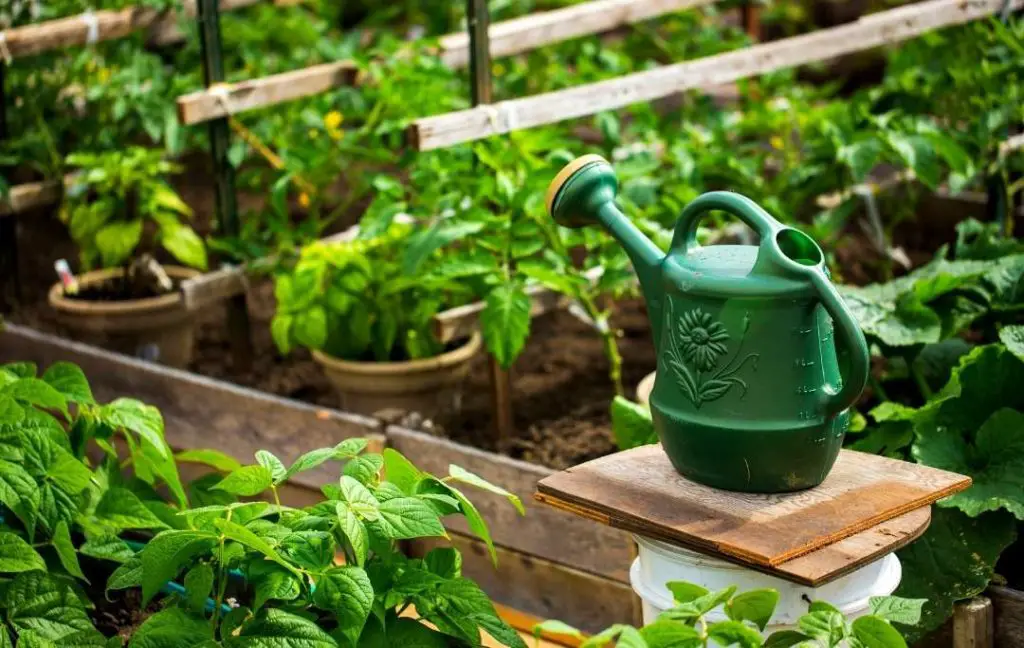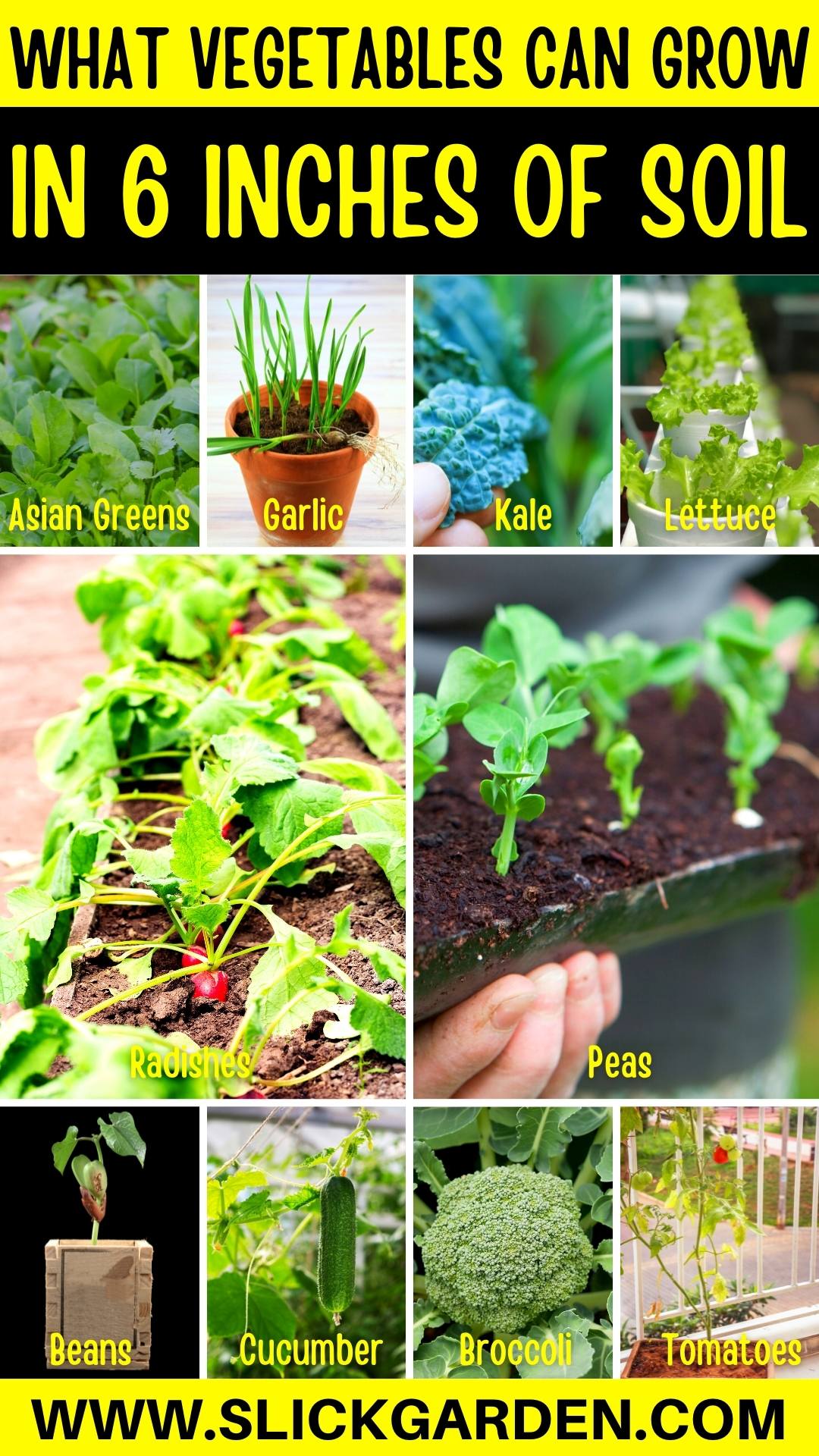If you grow vegetables at your home you will get fresh supplies of them for your kitchen. Fresh vegetables are very healthy as compared to store-bought vegetables.
You can grow vegetables in your garden, yard, raised beds, and pots. If you have limited space you can grow vegetables in race beds and pots. There are many ways of growing veggies but the method people like most is planting vegetables from the seeds.
Before growing any vegetable you have to do some research about the type of soil it likes to grow, the amount of water it needs, and what type of fertilizer you should apply. Make sure your vegetables grow in favorable conditions so they will give you a greater yield.

In this article, we are going to discuss with you those vegetables which can easily grow in 6 inches of soil. Make sure you choose suitable varieties according to the requirements of the vegetables.
If you are facing the problem of limited space then you can grow your vegetables in shallow containers. Place your containers or pots in the right where they get full sun exposure.
Vegetables That Can Easily Grow In 6 Inches Of Soil
If you are one of those who have limited space and you want to grow vegetables in a container or pot then this article will help you a lot. As in this article, we will discuss what types of vegetables you can easily grow in 6 inches of soil.
Most people think that if you grow plants in a smaller container or pot then they will need more water. You should not worry about this because you can maintain the frequency of water according to the weather conditions.
For example, on hot days you should increase the amount of water for your plants because your plants need extra moisturizer in summer. On hot days you can amend the soil with vermiculite. It will help to improve the drainage quality of soil and will also assist to retain the moisture for a longer time for your vegetables.

1- Asian Greens
Choy Sum, Tatsoi, and Bok Choy are Asian greens that can easily grow in shallow soil. Asian Greens are low maintenance plants and they can adjust to any environment. But you should keep the soil moist so your veggies will grow healthier.
Sunlight is an important factor for the growth of any plant so you should place your plants in full sun. Choose a location where your plants get full sun exposure.
If you place your plants at a place where they get at least 4 hours of sunlight. It will maintain the moisture in the soil and help to retain the moisture for a longer time. A layer of mulch controls the temperature of the soil in the winter.
Keep Reading: How To Grow Your Salad Greens Without A Garden?
2- Garlic
Garlic enhances the flavor of your dishes. If you want to get fresh garlic then you should grow it at your home. Garlic can easily grow in containers or pots. It is also included in the list of vegetables that can easily grow in six inches of soil.
Make sure your garlic plants get full sun exposure and well-drained soil. To improve the drainage quality of your soil you should add some sand. The pH of the soil must be between 6.0 and 8.0.
Each garlic needs 6 inches of space to grow. Proper spacing will help the garlic to expand in the soil. Keep the soil moist but not wet as garlic doesn’t like wet feet. Overwatering can result in root rot and fungal diseases so you should avoid it.
Read More: Easy Way Of Growing Garlic in Raised Beds
3- Kale
If you are looking for vegetables that can easily grow in shallow containers then kale is one of them. But you will not get the full size of kale if you plant it in a container.
The deep soil is the best place for growing kale. When you grow kale in containers, fill it with a rich potting mix. The essential nutrients will help to grow your plants. A high-quality potting mix has all the ingredients which your kill plant needs.
By adding manure or compost your plants will get the desired amount of nitrogen. Nitrogen helps to make your kale plants dense. A maximum of 5 hours of sunlight is necessary for the healthier growth of kale plants.
Juice the location where your plants get full sun exposure. When the size of the leaves is about your hand you can harvest the leaves.
Read More: How To Grow Kale In A Pot?
3- Lettuce
Lettuce doesn’t need more space to grow, so you can choose lettuce for growing in a shallow container. Letters like to grow in cold climates. The best temperature for growing letters is between 40 to 85 degrees Fahrenheit.
Lettuce plants need frequent, light, and consistent water. Keep the soil moist to encourage leaf growth. Overwatering can destroy your crop as it will cause root rot and fungal disease.
Caterpillars, slugs, and snails like to eat lettuce. The insecticide is the best option to get rid of these pests but hand-picking is an organic solution for this problem.
After 30 to 70 days your lettuce plants are ready to give you harvest. The maturity time of this plant depends upon the variety you choose for growing in shallow containers or pots.
When the size of lettuce reaches according to your desire then you can harvest it. Morning is the best time for harvesting lettuce so you will get the best flavor.
Read More: Best Hydroponic Lettuce Tower Money Can Buy
4- Radishes
You can easily grow radishes in 6 inches deep soil but a sunny location is ideal for your radish plants. In shady areas, your reddish plants will produce larger leaves rather than roots.
You can plant radish seeds in spring or fall but you should avoid summer. You can sow the radish seeds 4 to 6 weeks before the spring frost. You will get all the information about the dates of frost from any local nursery or gardening store. High temperatures may cause them to bolt.
The soil you use for filling your container or pot must be rich in organic matter. Compost will help to loosen the soil and improve its drainage. Some varieties of radish are ready to harvest after 3 weeks.
Do not leave the radish for a long time in the soil. You can pull one radish from the soil and examine it before harvesting the rest.
Read More: How To Grow Radishes From Scraps?
5- Peas
You can choose dwarf varieties of peas for growing in the shallow container in the 6 inches of soil. This is a cool-weather crop that can tolerate frost. Well-drained soil is perfect for growing peas at home. A sunny location is perfect for growing peace in a shallow container.
You can pick the peas when they are well filled. If you leave them for a long time then they will harden and their color will fade.
When the ports are plum and their color is well it is the best time to harvest them. When the pods are ready to harvest you can use our scissors for this purpose.
Read More: How to Grow Peas in Raised Beds
6- Beans
If you grow beans at home you can get a fresh supply of beans regularly. You can harvest dried beans at the end of this growing season. Dry beans can be stored for a long time.
It doesn’t matter what variety you are growing, the planting method is the same. Beans are available in different sizes, shapes, and colors. The suitable temperature for growing beans is about 65 to 75 degrees Fahrenheit.
The beans can easily grow in six inches of soil. Make sure you are using rich soil for filling your shallow container or pots. Bean seeds need one inch of water per week till germination.
Read More: How To Grow Beans In A Raised Bed Garden
7- Cucumber
Cucumbers like to grow in warm weather. The perfect temperature for growing cucumber should be 60 degrees Fahrenheit. Cucumbers need little maintenance so you can easily grow them in containers with 6 inches of soil.
Cucumbers need rich and fertile soil; you can add aged manure or compost to make your soil full of nutrients. After filling the container with the high-quality potting mix you can sow the seeds.
Now you should place your container in bright sunlight. Light and warmth are basic requirements for the healthier growth of your cucumbers. When your cucumber plants get 6 to 8 hours of sunlight then you will get better crops. Keep the soil moist by maintaining the frequency of water.
On hot days the soil dries very fast and drought can affect the flavor of the cucumbers. With the help of your finger, you can check the surface of the soil. If you feel it is dry then it is the time to water your plants.
Read More: Tips For Growing Cucumbers In Containers
8- Broccoli
Make sure you are using rich soil for growing broccoli. You can sow the seeds ¼ inches deep, 3 to 4 weeks before the last frost. Cabbage loopers, flea beetles, cutworms, and wireworms may attack your broccoli plants.
With the help of a stream of water, you can get rid of these tiny monsters. The soap-based spray is another solution to this problem.
Regular watering, full sun exposure, and plenty of organic matter will help the broccoli to thrive. Make sure you choose a sunny place for your shallow containers.
Phosphate and potassium are needed by broccoli as amendments. When your broccoli is mature, you can harvest it with the help of a sharp knife.
Read More: How to Grow Broccoli in Your Raised Beds?
9- Tomatoes
If you choose an intermediate type of tomatoes then it can easily adjust to 6 inches of soil. Not only cherry tomatoes but you can also grow beef tomatoes in 6 inches of soil.
The roots of tomato plants do not grow very deep. Tomatoes like to grow in moist soil; they can’t thrive in dry soil. Make sure you are using soil that has peat moss, coco peat, and perlite, all these ingredients make the soil rich and full of nutrients. Phosphorus and potassium make your soil rich for growing tomato plants.
Read More: How To Grow Roma Tomatoes In Pots?
10- Chards
Chard is among the vegetables that can easily grow in small spaces as it is not a fussy plant. A high-quality potting mix is perfect for filling your container for growing chards.
When you are sowing the seeds of chard then make sure there is space of 12 inches. Proper spacing will help to grow larger stalks and leaves.
When you grow plants in a container then make sure the plants are getting regular moisture. If you want to make your chard plants happy then keep the soil moist 2 inches deep.
The other requirement of the chart plant is full sun exposure. Choose a sunny location for your chard plant so it can develop properly. When the size of the leaves is according to your choice then you can harvest the leaves.
